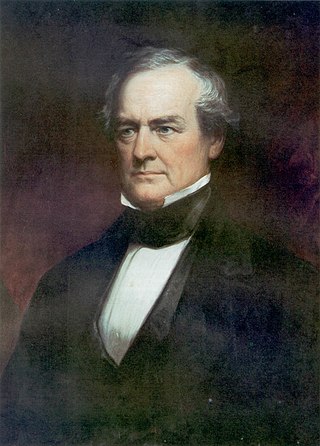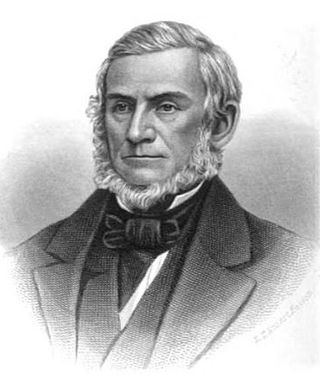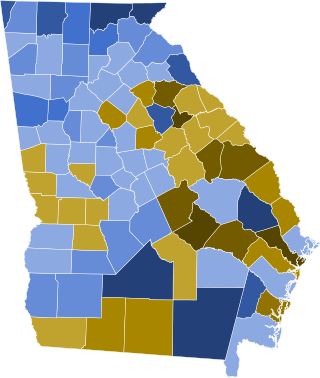
John Parker Hale was an American politician and lawyer from New Hampshire. He served in the United States House of Representatives from 1843 to 1845 and in the United States Senate from 1847 to 1853 and again from 1855 to 1865. He began his Congressional career as a Democrat, but helped establish the anti-slavery Free Soil Party and eventually joined the Republican Party.

George Walker Crawford was a licensed attorney turned politician from Columbia County, Georgia. Crawford was appointed attorney general for the state in 1827, by Governor John Forsyth, serving in that capacity until 1831. Crawford also served five years in the General Assembly's lower house as a representative of Richmond County on a platform of states' rights.
Southern Democrats are affiliates of the U.S. Democratic Party who reside in the Southern United States.

James Chamberlain Jones was an American politician who served as the tenth governor of Tennessee from 1841 to 1845, and as a United States Senator from Tennessee from 1851 to 1857. A Whig, Jones twice defeated future U.S. President James K. Polk for the governorship, in 1841 and 1843. He was the first native-born Tennessean to be elected governor of the state.

Lazarus Whitehead Powell was the 19th Governor of Kentucky, serving from 1851 to 1855. He was later elected to represent Kentucky in the U.S. Senate from 1859 to 1865.

Anthony Colby was an American businessman and politician from New London, New Hampshire. He owned and operated a grist mill and a stage line, and served as the 20th Governor of New Hampshire from 1846 to 1847.
Illinois is a Democratic stronghold in presidential elections and one of the "Big Three" Democratic strongholds alongside California and New York. It is one of the most Democratic states in the nation with all state executive offices and both state legislative branches held by Democrats. For most of its history, Illinois was widely considered to be a swing state, voting for the winner of all but two presidential elections in the 20th century. Political party strength in Illinois is highly dependent upon Cook County, and the state's reputation as a blue state rests upon the fact that over 40% of its population and political power is concentrated in Chicago, Cook County, and the Chicago metropolitan area. Outside of Chicago, the suburban collar counties continue trending Democratic while downstate Illinois can be considered more conservative with several Democratic leaning regions including Champaign-Urbana, Bloomington-Normal, Rockford, Peoria, and suburban St. Louis
The 1856 Massachusetts gubernatorial election on November 4. Incumbent Know-Nothing Governor Henry J. Gardner was re-elected to a third term. He benefited greatly from a deal with the state's new Republican Party, which agreed not to field a candidate in exchange for Gardner's support of presidential nominee John C. Frémont. With no serious challenger in the field against him, Gardner easily defeated Democrat Erasmus Beach and George W. Gordon, an American Party member running in support of the national ticket.
The 1852–53 Massachusetts gubernatorial election consisted of an initial popular vote held on November 8, 1852, followed by a legislative vote conducted on January 12, 1853, which elected Whig Party nominee John H. Clifford. The ultimate task of electing the governor had been placed before the Massachusetts General Court because no candidate received the majority of the vote required for a candidate to be elected through the popular election.
The 1851–52 Massachusetts gubernatorial election consisted of an initial popular vote held on November 10, 1851, followed by a legislative vote conducted on January 12, 1852. Incumbent Democrat Governor George S. Boutwell was reelected to a second term in office. The ultimate task of electing the governor had been placed before the Massachusetts General Court because no candidate received the majority of the vote required for a candidate to be elected through the popular election.

The 1851 Georgia gubernatorial election was held on October 6, 1851.

The 1847 Georgia gubernatorial election was held on October 4, 1847.

The 1849 Georgia gubernatorial election was held on October 1, 1849.

The 1841 Georgia gubernatorial election was held on October 4, 1841, to elect the governor of Georgia. Incumbent Democratic Governor Charles McDonald won re-election defeating Whig State Rights candidate William C. Dawson.

The 1839 Georgia gubernatorial election was held on October 7, 1839, to elect the governor of Georgia. The Democratic Union candidate Charles McDonald won the election defeating Whig State Rights Candidate Charles Dougherty, with the election being decided by 1,907 votes.
The 1842 Massachusetts gubernatorial election consisted of an initial popular election held on November 14, 1842 that was followed by a legislative vote held on January 17, 1843. The ultimate task of electing the governor had been placed before the Massachusetts General Court because no candidate received the majority of the vote that was constitutionally required for a candidate to be elected through the popular election. Incumbent Whig Governor John Davis was defeated by Democratic nominee and former Governor Marcus Morton.
The 1843–44 Massachusetts gubernatorial election consisted of an initial popular election held on November 13, 1843, that was followed by a legislative vote held on January 8, 1844. The ultimate task of electing the governor had been placed before the Massachusetts General Court because no candidate received the majority of the vote that was constitutionally required for a candidate to be elected through the popular election. Incumbent Democratic Governor Marcus Morton was defeated by Whig Party nominee George N. Briggs.

The 1842 New Hampshire gubernatorial election was held on March 8, 1842.
The 1845–46 Massachusetts gubernatorial election consisted of an initial popular election held on November 10, 1845 that was followed by a legislative vote held on January 12, 1846. The ultimate task of electing the governor had been placed before the Massachusetts General Court because no candidate received the majority of the vote required for a candidate to be elected through the popular election. Incumbent Whig Governor George N. Briggs defeated Democratic nominee Isaac Davis, Liberty Party nominee Samuel E. Sewall and Know Nothing nominee Henry Shaw.












